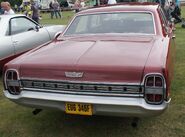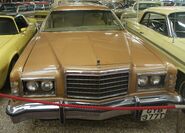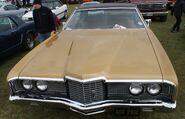
Ford LTD
The Ford LTD was a car produced by the Ford Motor Company in North America. A range of full-size cars wore various forms of the LTD nameplate from 1965 to 1991 in the United States. The LTD debuted as the highest trim level on the 1965 full-size Ford range under the name Galaxie 500 LTD and became its own series for the first time in 1966.
In 1983, the LTD was split into two distinct lines. The LTD shifted to a mid-size car based on the Fox platform; the top-trim LTD Crown Victoria remained a full-size car. The smaller LTD continued in sedan and station wagon forms through 1986, overlapping with the first model year of the Ford Taurus in 1986, the car that became its successor. In North America, the LTD name was last used on the 1991 LTD Crown Victoria sedan and station wagon, which dropped it for 1992.
Origin of Name[]
The LTD designation is considered by some an abbreviation of "Luxury Trim Decor" and by others as a limited body style classification for the Galaxie. There is evidence that, at least in Australia, it originally stood for "Lincoln Type Design." The original "Car Life" review at the time the first LTD was released suggests that it stood for nothing and was just three meaningless letters.
1965-1968[]
The line was introduced in 1965 as the Galaxie 500 LTD (and for the first year was badged as such), in response to the introduction of the Chevrolet Caprice and the similar Dodge Monaco and Polara. These upscale models had features found primarily on luxury models from these same manufacturers, but were sold with much lower retail prices. The standard upgrades on these cars were power windows, a power driver's seat, power brakes, power steering, air conditioning, a full or half-vinyl top (called a landau or brougham randomly across different models by the same manufacturers). Another list of upgrades were interiors made of better materials and more powerful engines. Most of these upper trim models were usually all hardtops as opposed to pillared bodies.
1968 would be a transition year. Though it retained the same body and frame of the 1965-1967 models, the 1968 model featured horizontal hidden headlights and a more formal looking roof style. It was the last model with the 119" wheelbase.
The LTD was split off into its own model for 1967, while the Galaxie name continued on lower-line models through 1974. The Custom 500 remained as a fleet model in the U.S. and the base model in Canada through 1978.
A limousine version of the car was also considered, with the extra length at the C-pillar and the rear doors. At 1969-1972
From 1969 to 1970, the LTD shared top-of-the line trim pieces featuring a grille with hidden headlamps; these were shared with the Galaxie XL sport coupe and the Country Squire station wagon. While continuing styling concepts introduced in the 1968 model (hidden headlights and a formal roofline), the 1969 model delivered many changes. The most notable of these was a longer (121-inch) wheelbase as part of an all-new body. Styling featured a grille with a body-color horizontal divider. For 1970, this was dropped, with a center grille separated from the side sections.
For 1971, the LTD received a more extensive facelift. In the rear, the long-running styling theme of twin round or square "jet exhaust" taillights were replaced by horizontal taillights on all full-size Fords. The LTD lost its distinctive hidden headlamps, but had the LTD grille badge, side trim, and tail which had a center taillight featuring a center "third" brakelight. For comparison, this was an alloy trim panel on the Galaxie 500 while on the Custom 500, the space between the taillights was body-color sheetmetal. The 1972 front end featured flush grilles instead of the concave treatment of the 1971 models and an additional bumper bar extended across the center grille section, while the rear received a large high chrome bumper into which taillights were set. In the rear, the trunk lid was squared off.
The XL sport model ended production in 1970, but for 1971 at least 1,585 sport coupe and convertibles were produced with bucket seats and center consoles; the console was similar to the console in the XLs and Mercury Marauders of 1969-70, with a "stirrup" style shift handle. 1972 would be the final year for LTD convertibles.
1973-1978[]
The LTD was redesigned for 1973. While the new LTD weighed less than earlier models, it was still far in excess of two tons, meaning that agility and fuel economy were both weak points. The base engine was the 302 CID V8. The next largest engine was Ford's 351 CID V8, which was the most common choice. Still larger was Ford's 400 CID V8, and topping the range starting in 1975 was Lincoln's 460 CID V8, which gave good power but got less than 10 mpg in city traffic. The sister 385/lima engine 429 was previously available until 1974, then replaced by the 460. All of these engines were choked by emissions systems and retarded camshaft timing, with the 400 and 429/460 engines producing large amounts of torque but a power output of 160-180 hp, depending on which year.(Down from 260 for the 400, and 365 for the 429 in 1971) Despite these difficulties, the full-sized Fords remained strong sellers each year during this period, due to their high comfort, good build quality and reasonable cost.
The Galaxie nameplate was discontinued after 1974, leaving the Custom 500 as the base trim full-size Ford, then LTD, LTD Brougham, and the new LTD Landau at the top of the series for the 1975 model year. The Landau came with hidden headlamps and available rear fender skirts, and was also available with various decor packages for additional luxury. The Brougham trim was dropped from the lineup for 1977. The regular LTD station wagon had exposed headlamps; the LTD Country Squire wagon had simulated woodgrain body trim as in previous years, and from 1975-78 had the same hidden headlamps as the LTD Landau.
LTD II[]
Main article: Ford LTD IIWhen Ford updated its mid-size product line for 1977, they took on the LTD name as well. To differentiate them from the full-size product lineup, the mid-size cars were called the LTD II. The LTD II served as the replacement for the Torino and the Elite, while the platform was also used by the final generation of the Ranchero. It was discontinued after 1979 without being replaced, as the new Panther-platform LTD was nearly a foot shorter than an LTD II and the Granada became Ford's mid-size product line in its 1980 redesign.
Panther-platform (1979-1982)[]
Downsized two years after its main rivals, the Chevrolet Impala and Caprice, the 1979 LTD was fifteen inches shorter than the 1978 model (and ten inches shorter than the "mid-size" LTD II). However, the interior remained just as large as the previous LTD, and the whole design became more efficient. The reduced size and weight led to improved road manners and maneuverability, with ride quality and fuel economy improving as well. The two base engines, the 302 and 351 Windsor V8s, were carried over from 1978; the big-block 400 and 460 V8s were discontinued. For 1981 and 1982, to further improve fuel economy (while avoiding diesel or 6-cylinder engines), Ford introduced a 255 cu in (4.2 L) variant of the Windsor V8. The 255 proved an unreliable and unpopular choice; at 115 hp, its output was ill-suited for the LTD's two-ton curb weight.
In the U.S, LTD and LTD Landau models were carried over from 1978. In Canada, the Custom 500 continued as the base model through 1981. Low-end cars were identifiable by single square headlamps, while the higher models received duals. For 1979, the LTD S was added as a lower-priced model and the Crown Victoria replaced the Landau on a permanent basis; it had a landau roof with a targa-like chrome band. First introduced in the mid-1950s, the Crown Victoria returned as a trim package for the LTD in 1975; its Mercury equivalent was the Grand Marquis.
For 1983, as part of a major product shift, the LTD and LTD Crown Victoria were split into separate product lines. The LTD was downsized to the Fox platform (and Mercury Marquis) to replace the Granada, while the full-size LTD Crown Victoria became a stand-alone model (along with the Mercury Grand Marquis).
Fox-platform (1983-1986)[]
Ford's final family sedan based on the Fox platform, the LTD, and its Mercury twin, the Marquis, were basically a restyle of the unsuccessful 1981-1982 Ford Granada and Mercury Monarch, and the popular 1978-1983 Ford Fairmont and Mercury Zephyr. As such, the running gear was identical to the Fairmont. The LTD and Marquis monikers were also used on the full size sedan and wagon, named LTD Crown Victoria and Grand Marquis.
Both LTD and Marquis inherited the Fairmont's 2.3 L four-cylinder, 3.3 L inline-six, and 5.0 L V8 engines; however, the V8 gained fuel-injection. Inherited from the Granada was Ford's 3.8 L Essex V6, which gave smooth and reliable power, although with sometimes troublesome head gaskets. The Essex engine gained fuel injection for 1984 in the US; it was carbureted in Canadian markets until 1986. An option from 1983 to 1984 was an LPG (propane)-powered four-cylinder engine, but was discontinued due to poor sales and few propane fueling stations. The LTD's final year was 1986, when Ford sold it alongside its replacement, the Taurus as Ford wanted to hedge its bets if the radically-designed Taurus would flop. This car was the third-best-selling car in the United States in 1983 and 1984.
LTD LX[]
During the 1984 model year, Ford introduced a performance version of the LTD called the LTD LX. It came standard with the high output 5.0 L CFI V8 engine, four-speed automatic transmission with overdrive, 600 lb-in front and 270 lb-in rear coil springs, front and rear sway bars, 10 inch front disc and 10 inch rear drum brakes, and a 3.27:1 rear gear ratio with a Traction-Lok differential. The LX model was the only LTD to have a tachometer in the instrument cluster. the center console with a floor-mounted shifter for the transmission re-appeared having last been available in the full-size 1972 model year. Roughly 3,260 LXs were produced from mid-1984 to 1985. The Mercury version of the LX was the Marquis LTS and was available only in Canada in much smaller numbers. A LTD (fox body) police edition was as also made, roughly 800 were produced. Notable for its bigger sway bars and brakes, it also included bench seats with an automatic trunk opener located underneath the steering wheel. They were a factory option and most were equipped with light bars and police accessories, although some came without.
Brazil[]
The LTD was also produced locally in Brazil between 1967 and 1983, based on the 1966 version of the Ford Galaxie. A locally produced stretch limousine was also produced.








